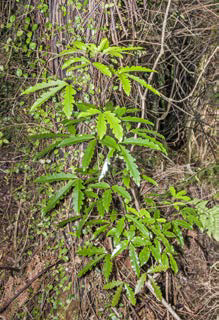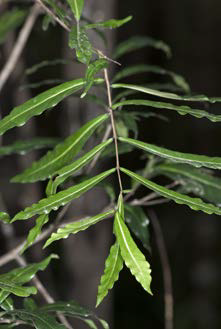Trip Report – 30 November – 1 December 2013: Wairarapa
Day 1: Pukaha Mount Bruce
 |
| Raukauaua edgerleyi. Photo: Jeremy Rolfe. |
National Wildlife Centre staff members Claire and Susie kindly gave us the use of the class-room for our briefing, and later for reconvening as we returned after botanising the circular Bush Walk.
We started with lists of native plants and birds that BotSoccers Pat Enright and Tony Silbery had prepared in 2008. As we progressed slowly past the aviaries, then up through impressive rimu-totara forest, the nor’west gale gained intensity, and brought bursts of rain. In our water-proof gear, we were undeterred and continued looking and listing, partly protected from the tempest by Tane’s tall trees. We added over twenty species of native plants, including pokaka seedlings with their leaves a multitude of shapes,
Raukaua edgerlyi with its scented, lobed leaflets,
Urtica ferox / onganga / tree nettle, and its tiny relative,
Urtica incisa / scrub nettle,
Solanum aviculare,
Parsonsia capsularis, and the ferns
Pteris macilenta and
P. tremula.
We began a list of weed species, and thanks mainly to Graeme, listed nearly sixty species, some of the pest plants, and one, with its own label, the lacebark
Hoheria populnea, which is native to Waikato and further north, but south of there is weed. Pukaha has been subject to intensive pest control for about ten years, to encourage the return of native plants and birds. Despite notable successes, with bird species flourishing, and palatable native plant species becoming more numerous, we noted browse on blueberry,
Libertia sp., and
Uncinia uncinata. There can be no let-up with pest control.
After lunch, we drove south to “Riversong”, on the banks of the Ruamahanga River, where we enjoyed tea, pikelets, and a discussion on Wairarapa botany and pest control, with our hosts, Trevor Thompson and Jill Herrick, before botanising in their fascinating backyard. Here we saw several species of mistletoes, planted and flourishing, on a variety of host species. The mistletoe / host combinations included:
Ileostlyus micranthus on
Coprosma propinqua,
Tupeia antarctica planted on
Ileostlyus micranthus, itself planted on tree lucerne,
Tupeia antarctica on tarata,
Peraxilla tetrapetala on black beech,
P. colensoi on silver beech, and
Alepis flavida on black beech. It was a real eye-opener to see what Trevor has achieved over many years of experimenting with growing these threatened, native, parasitic plants, on trees and shrubs.
Day 2: Fensham Bush Reserve
 |
| Mida salicifolia. Photo: Jeremy Rolfe. |
A complete change from the preceding day’s storm allowed us a leisured exploration of Forest & Bird’s 48-ha Fensham Reserve, using a compilation of lists begun by Druce 1969, followed by Enright, John, Brownsey, Chamlet, Gawith, Knox, Lynch and Stapleton, accompanied by un-named Forest & Bird members. With this existing, substantial data set in our hands, it was no wonder we didn’t find any indigenous additions on the day. After an informative briefing by Chris Surman and Geoff Doring, both of Wairarapa Branch, Forest & Bird, we then split into groups, each to return by 3.30 p.m. A feature of this reserve is its varied topography from lowland wetland to well-drained spur crests. A feature in the wetland is an extensive grove of saplings of the NZ endemic, parasitic, member of the
Nanodeaceae family,
Mida salicifolia, willow-leaved maire, growing in semi-shade. Unfortunately there were no flowers or fruit within reach on the largest tree, but we were able to observe closely the way
Mida leaves are alternate to sub-opposite, narrow like young white maire, but a much darker green. We have found mida several times in recent years in the Wairarapa, but it is much less common in Wellington ecosystems.
Higher up the slopes under kanuka and beech we were able to practise our new names for the NZ beeches,
Fuscopora fusca / red beech,
Fuscopora solandri / black beech, and
Fuscopora truncata / hard beech. Geoff proudly showed us one of their rarities, the only
Nestegis montana / narrow-leaved maire known in the reserve, just as there is only one known to us in Otari.
Barbara Mitcalfe
Participants : Jill Broome, Gavin Dench, Geoff Doring, Bryan & Robin Halliday, Chris Horne (leader / co-scribe) Graeme Jane, Sheelagh Leary, Rodney Lewington, Barbara Mitcalfe (co-scribe) Syd Moore, Lea Robertson, Darea Sherratt, Sunita Singh, Julia Stace, Chris Surman.

 Site Index
Site Index







 Site Index
Site Index





